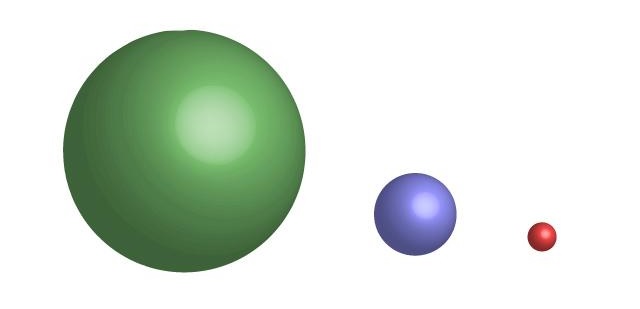 This illustration shows the sizes of triatomic molecules that follow the geometrical scaling predicted by Vitaly Efimov in 1970. Credit: Cheng Chin group, University of Chicago
This illustration shows the sizes of triatomic molecules that follow the geometrical scaling predicted by Vitaly Efimov in 1970. Credit: Cheng Chin group, University of Chicago
"This is a new rule in chemistry that molecular sizes can follow a geometric series, like 1, 2, 4, 8...," said Cheng Chin, professor in physics at the University of Chicago. "In our case, we find three molecular states in this sequence where one molecular state is about 5 times larger than the previous one."
Vitaly Efimov, a Russian theoretical physicist first predicted this phenomenon in 1970. "Quantum theory makes the existence of these gigantic molecules inevitiable, provided proper--and quite challenging--conditions are created," said Efimov, now at the University of Washington.
A single lithium atom and two caesium atoms make up the three molecules in the series. These were observed by the team at the University of Chicago in a vacuum chamber at a temperature of approximately 200nK, which is slightly above absolute zero.
When an infinitely large universe is considered in this caesium-lithium system, the number of increasingly larger molecules would extend to infinity. This innovative idea is based on the laws of quantum mechanics.
“These are certainly exotic molecules,” said Shih-Kuang Tung, the postdoctoral scholar, now at Northwestern University, who led the project. The geometric scaling in the Efimov molecules could only be observed under stringent conditions. The team found that the Efimov state could not be achieved using two or four atom molecules. “There’s a special case for three atoms,” said Cheng Chin.
Efimov was astounded with the research. “First, I am amazed by the predictive power of the quantum theory,” he said. “Second, I am amazed by the skill of the experimentalists who managed to create those challenging conditions.”
This discovery shows that Efimov molecules follow a simple mathematical rule, in the same manner as other complex phenomena. Snowflakes also display geometric scaling due to their microscopic hexagonal crystal structures.

Image Credit: ruigsantos / Shutterstock.com
In 2006, at the University of Innsbruck in Austria, the first Efimov molecular state in molecules with three caesium atoms was observed by a research team which Chin was a part of. At temperatures slightly above absolute zero, the three caesium atoms became entangled in the Efimov state. A Borromean ring comprising three interlocking circles was formed, however any two of them would not interlock.
“The difficulty is that based on what we understand of Efimov’s theory, the scaling factor is predicted to be 22.7 for the cesium system, which is a very large number,” explained Chin, who also is a member of the University of Chicago’s James Franck and Enrico Fermi institutes. An extremely low temperature is required for scaling at such a huge value, which is very difficult to achieve.
The lithium-caesium triatomic molecule’s scaling factor was however predicted to be 4.8, which was more manageable. Indeed, after setting up their experiment, “We were able to see three of them at a more accessible temperature of 200 nano-Kelvin,” Chin said. “Their sizes are measured to be 17, 86 and 415 nano-meters, respectively. They closely follow a geometric progression with the predicted scaling factor.”
Difficulty was observed with the lithium-caesium system, which were the considerably varying masses of the two elements. This is very important for observing multiple Efimov states. Caesium is quite heavy, while lithium is one among the lightest elements. “One is really massive compared to the other,” Tung said.
The temperatures of the caesium and lithium atoms were lowered by the University of Chicago physicists separately, and they were then brought together so that they formed the Efimov molecules.
“It’s a very complicated experiment,” Tung said, one requiring an ultracold experimental tool called Feshbach resonance. Feshbach resonance, when performed in a magnetic field enabled the researchers to control and bind the interactions that occur between lithium and caesium atoms.
Through the Feshbach resonance, cold atoms are manipulated and this allows examination of geometric scaling. “Feshbach resonance is a really important tool for us,” Tung said. Over the past three years, Tung has along with his associates learned to use the tool effectively.
“We needed to tune the Feshbach resonances very carefully in order to generate these Efimov molecules,” Tung said.
Their efforts paid off, and the experiment was a success. Efimov said the results made him feel like the parent of a successful child. “The parent is proud of the child’s achievement, and he is also proud that in a sense he is part of the child’s success.”
The study was published by Chin, along with four members of his research group in the journal, Physical Review Letters.